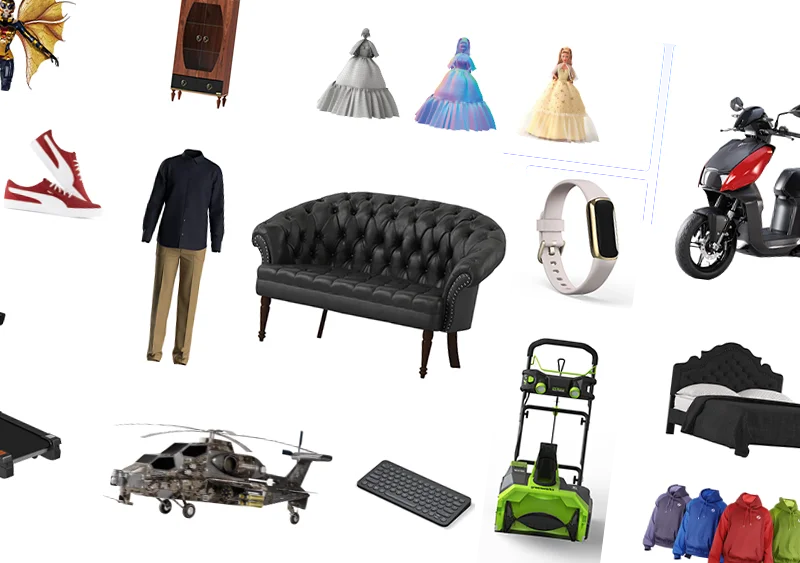Top 7 Benefits of 3D Rendering Services for E-Commerce
7 Ways 3D Rendering Enhances E-Commerce Sales & Engagement

5 MIN READ
March 4, 2025

Written By
Harish Selvaraj
Product images can make or break an online sale. In a competitive eCommerce market, customers expect more than flat, static photos. They want interactive, lifelike visuals that help them understand a product’s details before making a purchase. This is where Outsource 3D rendering services come in.
Unlike traditional photography, 3D rendering allows businesses to create high-quality, customizable product visuals without the need for expensive photoshoots. Brands using 3D product visualization see higher engagement, better conversions, and lower return rates.
But what are the key benefits that make this technology a game-changer for online retailers?
Let’s dive in.
Top 7 Benefits of 3D Rendering Services for E-Commerce
E-commerce businesses are constantly searching for ways to improve customer experience, increase conversions, and reduce operational costs. 3D rendering technology is helping brands achieve all three. Unlike traditional product photography, 3D rendering creates photorealistic digital representations of products, offering a dynamic and engaging shopping experience.
Here are seven powerful benefits of integrating 3D rendering services into your eCommerce strategy.
1. Improved Customer Engagement: Turning Browsers into Buyers
Customers are more likely to interact with products they can explore in detail. 3D product visualization allows users to zoom, rotate, and view items from every angle, creating an interactive shopping experience that static images simply cannot provide.
-
Studies show that shoppers spend up to 50% more time on product pages with 3D models for ecommerce compared to those with only standard images.
-
The ability to manipulate and inspect a product digitally increases buyer confidence, making them more likely to proceed with a purchase.
Engagement is key in eCommerce, and the longer customers interact with a product, the higher the chances of conversion.
2. Higher Conversion Rates: More Informed Customers, More Sales
One of the biggest obstacles in online shopping is the lack of physical interaction with a product. Traditional images often fail to give customers a complete understanding of size, material, and functionality.
-
3D rendering bridges this gap by providing lifelike, customizable product visuals, leading to 20-40% higher conversion rates compared to traditional images.
-
Customers who can explore products in a more realistic and interactive way feel more confident about their purchase decisions, reducing hesitation and cart abandonment.
When shoppers see exactly what they are getting, they are more likely to complete their purchase.
3. Reduced Return Rates: Fewer Surprises, Happier Customers
One of the leading causes of online returns is that the received product does not match customer expectations. Misleading product images or unclear descriptions contribute to this problem.
-
With 3D rendering, businesses can display products with accurate dimensions, materials, and textures, ensuring customers know exactly what they are buying.
-
Studies indicate that 3D visualization can reduce return rates by up to 30% by setting proper expectations and minimizing order mismatches.
Fewer returns mean lower operational costs and higher customer satisfaction, making 3D rendering a smart investment for eCommerce businesses.
4. Competitive Differentiation: Standing Out in a Saturated Market
With millions of products available online, brands need to stand out. 3D rendering allows businesses to showcase products in ways that competitors using traditional images cannot.
-
Hyper-realistic visuals create a premium feel, helping brands establish a strong identity.
-
Businesses that adopt 3D visualization early gain a first-mover advantage, positioning themselves as industry leaders in customer experience.
-
Interactive models encourage social sharing, increasing brand visibility and driving organic traffic.
By offering a visually superior shopping experience, companies can attract more customers and build stronger brand loyalty.
5. Cost Savings in Product Photography: A Smarter Alternative
Traditional product photography is time-consuming and expensive. Each product variation requires a new photoshoot, adding to operational costs.
-
3D rendering eliminates the need for physical prototypes and multiple photography sessions, reducing expenses on photography, studio setups, and logistics.
-
Businesses can create and modify unlimited product variations digitally, saving thousands of dollars on re-shoots.
A single 3D model can generate multiple views, angles, and lifestyle images, making it a more efficient and cost-effective solution for eCommerce brands.
6. Scalability and Customization: Unlimited Product Variations with Minimal Effort
As businesses expand their product lines, managing images for different variations becomes a challenge. 3D rendering makes scaling effortless.
-
Companies can quickly change product colors, textures, and materials without the need for new photography.
-
Customization tools allow shoppers to personalize products in real-time, increasing engagement and potential sales.
-
New product releases can be marketed faster by generating high-quality visuals instantly, instead of waiting for production and photoshoots.
This flexibility allows brands to stay ahead of demand while keeping operational costs low.
7. Integration with AR and VR: Enabling Next-Generation Shopping Experiences
Augmented reality and virtual reality are reshaping how customers shop online. 3D-rendered models are the foundation of these advance technologies.
-
AR allows customers to visualize products in their real-world environment, whether it is placing furniture in their living room or trying on eyewear virtually.
-
VR enhances immersive shopping experiences, letting customers walk through virtual showrooms or interact with products in a simulated space.
-
Retailers using AR and VR-powered 3D models see a significant increase in engagement and purchase confidence, making them pioneers in digital commerce.
As these technologies become more widespread, businesses that adopt 3D models early will be positioned at the forefront of the future of eCommerce.
Conclusion
3D rendering is a powerful tool that elevates customer experiences, drives sales, and lowers operational costs. From boosting engagement to seamlessly integrating with AR and VR, the benefits of 3D models in eCommerce extend far beyond traditional product images
Brands that embrace high-quality 3D visualization gain a competitive edge, attract more customers, and see real business growth. As online shopping continues to evolve, companies that invest in 3D technology today will lead the future of eCommerce.
Want to bring your products to life with cutting-edge 3D rendering? Contact ZealousXR today for your 3D Rendering Services!
About the writer :
Harish Selvaraj heads Zealous Services' 3D animation and modeling projects, bringing over 17 years of experience in ... delivering top-tier 3D solutions. He collaborates directly with clients to ensure their ideas are transformed into powerful 3D results that meet both creative and business goals. Harish is deeply involved in driving sales and managing teams, making sure that each project delivers on quality while helping businesses grow through impactful 3D designs.
Read MoreFrequently Asked Questions (FAQ)
How does 3D rendering improve customer engagement in eCommerce?
3D rendering creates interactive product experiences, allowing customers to rotate, zoom, and explore products in detail. Unlike static images, interactive 3D models keep shoppers engaged longer, leading to higher interest and purchase intent. Studies show that customers spend up to 50% more time on product pages with 3D models.
Can 3D rendering actually increase conversion rates?
Yes, businesses using 3D product visualization see conversion rates improve by 20-40%. Shoppers feel more confident when they can view a product from every angle, reducing uncertainty and hesitation. The more detailed and accurate the product presentation, the more likely customers are to complete their purchase.
How does 3D rendering help reduce return rates?
Returns often happen when a product does not match customer expectations. 3D rendering provides a highly detailed and realistic view, reducing the chances of misinterpretation. With accurate textures, dimensions, and interactive features, brands using 3D visualization report up to a 30% drop in return rates.
Is 3D rendering more cost-effective than traditional product photography?
Absolutely. Traditional photography requires physical samples, studio setups, and multiple photoshoots for different product angles and variations. With 3D rendering, businesses can create photorealistic product images without physical inventory, saving on production and logistics costs. A single 3D model can generate multiple angles, lifestyle shots, and color variations, making it a more efficient and budget-friendly alternative.
How can 3D rendering be integrated with AR and VR technologies?
3D-rendered models are the foundation of augmented reality (AR) and virtual reality (VR) experiences. AR allows customers to see how a product fits in their space, while VR enables immersive shopping experiences like virtual showrooms. Many eCommerce platforms now support 3D and AR integrations, making it easier for brands to adopt these cutting-edge solutions.
Table Of Contents
Top 7 Benefits of 3D Rendering Services for E-Commerce
Improved Customer Engagement: Turning Browsers into Buyers
Higher Conversion Rates: More Informed Customers, More Sales
Reduced Return Rates: Fewer Surprises, Happier Customers
Competitive Differentiation: Standing Out in a Saturated Market
Cost Savings in Product Photography: A Smarter Alternative
Scalability and Customization: Unlimited Product Variations with Minimal Effort
Integration with AR and VR: Enabling Next-Generation Shopping Experiences
Conclusion